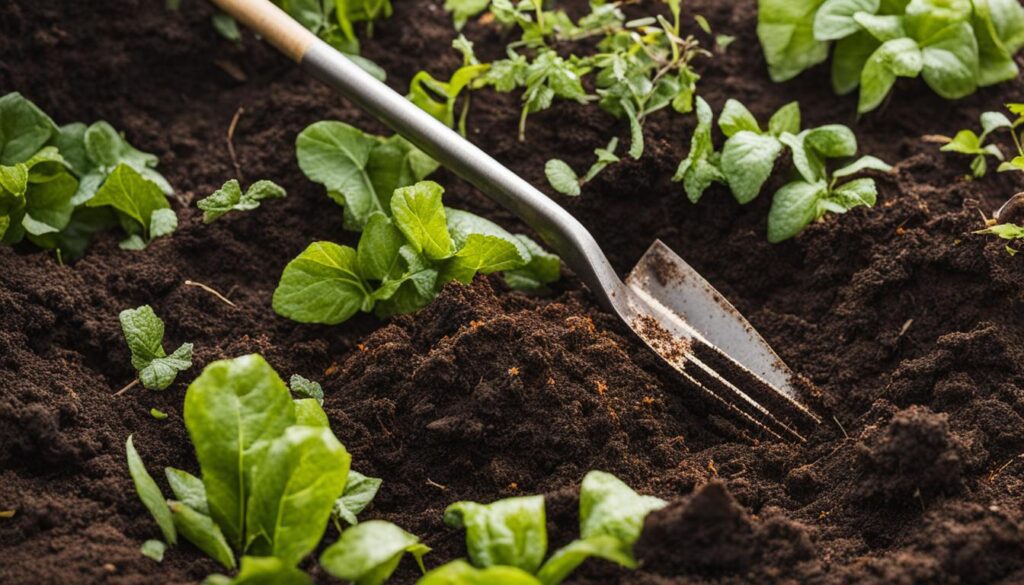Are you ready to create a beautiful, low-maintenance garden that conserves water and thrives in any climate? Look no further than a xeriscape garden. However, to ensure the success of your xeriscape garden, proper soil preparation is key. Neglecting the health of your soil can hinder the growth and vigor of your plants, making it crucial to give your soil the attention it deserves.
Preparing the soil for a xeriscape garden involves a few essential steps. You’ll need to understand the composition of your soil, test its pH levels, amend it with organic matter, enlist the help of microorganisms, and mulch appropriately. By following these expert tips, you’ll create an optimal environment for your xeriscape garden to flourish.
Key Takeaways:
- Understanding your soil type is crucial for xeriscape gardening success.
- Testing and adjusting soil pH levels ensures proper nutrient availability.
- Adding organic matter improves soil structure and fertility.
- Enlisting the help of microorganisms benefits plant growth and health.
- Mulching appropriately conserves moisture and suppresses weeds.
Understanding Your Soil Type
Before you embark on creating your xeriscape garden, it is essential to have a clear understanding of your soil type. Soil can be classified into four main types: clay, sandy, silt, and loam. Each type has its own unique characteristics that can significantly impact the drainage, nutrient retention, and overall density of your soil.
Clay soil: This type of soil has small particles that hold moisture and nutrients effectively, but it drains slowly. While clay soils can be fertile, they can become compacted and hard when dry, making it challenging for plants to establish roots.
Sandy soil: Sandy soil, on the other hand, has larger particles that drain quickly. While this type of soil allows for good drainage, it tends to have low nutrient retention. Plants grown in sandy soil may require more frequent watering and additional fertilization to thrive.
Silt soil: Silt soil consists of fine particles that have excellent moisture retention but can inhibit drainage. It is often fertile and easy to work with, making it suitable for many plants.
Loam soil: Considered the ideal soil type for most plants, loam soil is a well-balanced mixture of sand, silt, and clay. It offers good drainage, retains moisture, and has excellent nutrient-holding capacity. Loam soil is generally fertile and provides an optimal environment for plant growth.
By understanding your soil type, you can make informed decisions about the appropriate amendments and preparations necessary for your xeriscape garden. Whether you need to improve drainage, enhance nutrient retention, or adjust pH levels, catering to your soil type will help create a thriving and sustainable garden.
Quote:
“Knowing your soil type is the first step towards successful gardening. It allows you to tailor your approach to suit the specific needs of your plants and ensures optimal growing conditions.”
- Understand your soil type: clay, sandy, silt, or loam.
- Clay soil holds moisture and nutrients but drains slowly.
- Sandy soil drains quickly but lacks nutrient retention.
- Silt soil retains moisture but inhibits drainage.
- Loam soil, a balance of all types, is ideal for most plants.
Testing and Adjusting Soil pH
In order to create an optimal environment for your xeriscape garden, it is imperative to test and adjust the pH of your soil. The pH level of your soil determines its acidity or alkalinity, both of which can greatly impact nutrient availability to plants. To ensure the success of your low-maintenance garden, follow these steps to test and adjust the pH:
- Obtain a soil testing kit or send a sample to a professional for analysis.
- Collect soil samples from different areas of your garden, as pH levels can vary.
- Follow the instructions provided with your testing kit or send the samples to the designated laboratory.
- Once you receive the results, take note of the soil’s pH level.
- If the soil is too acidic (pH below 6), you can increase its alkalinity by adding lime. Apply the recommended amount according to the package instructions, working it into the soil.
- For soils that are too alkaline (pH above 7), reduce their acidity by adding powdered sulfur or aluminum sulfate. Again, follow the instructions on the packaging to determine the appropriate amount and work it into the soil.
Testing and adjusting soil pH ensures that your plants can properly absorb essential nutrients, resulting in healthy growth and vitality. It is an important step in the preparation of your xeriscape garden.
How Can Sustainable Soil Management Practices Benefit Xeriscape Garden Soil Preparation?
Sustainable soil management in xeriscaping can greatly benefit the soil preparation for a xeriscape garden. By implementing practices such as organic mulching, composting, and minimal tilling, the soil can retain moisture more efficiently and support the growth of drought-resistant plants. This approach promotes long-term soil health and water conservation.
Adding Organic Matter for Soil Improvement
To improve the structure and fertility of your soil for a successful xeriscape garden, adding organic matter is key. Organic matter, such as compost, manure, and fallen leaves, provides numerous benefits to the soil and the plants that grow in it.
One of the main advantages of organic matter is its ability to enhance water-holding capacity. It acts like a sponge, allowing the soil to retain moisture for longer periods, which is especially important in xeriscape gardening where water conservation is a priority.
Organic matter also improves nutrient retention in the soil. It acts as a reservoir, holding essential nutrients and gradually releasing them to the plants. This helps maintain a steady and balanced supply of nutrients, promoting healthy growth and development.
In addition, organic matter serves as a food source for beneficial soil organisms. It attracts earthworms, bacteria, fungi, and other microorganisms that contribute to soil health. These organisms break down the organic matter, releasing even more nutrients and improving soil structure.
Compost and Manure: The Power Duo
“Compost and manure are the dynamic duo when it comes to organic matter for soil improvement,” says gardening expert Jane Smith.
Compost is a rich source of organic matter that you can easily create at home by composting kitchen scraps, yard waste, and other organic materials. It is packed with nutrients and beneficial microorganisms that can revitalize and nourish your soil.
Manure, on the other hand, provides a concentrated source of nutrients and organic matter. It is important to use well-aged and fully composted manure to avoid burning or damaging plants with excessive nitrogen content. When properly applied, manure can help improve soil fertility and structure.
When adding organic matter to your soil, it is best to work it into the top few inches of the soil. This allows for better incorporation and distribution of the organic matter throughout the planting area. Adding a layer of organic matter annually, particularly in the fall, will continually enrich the soil and support the growth of your xeriscape garden.
Conclusion
Proper soil preparation is essential for creating a successful xeriscape garden that is low-maintenance and water-efficient. By following these soil preparation tips, you can ensure the optimal growth and health of your plants while minimizing the need for excessive watering and upkeep.
Understanding your soil type is the first step in preparing your xeriscape garden. Whether you have clay, sandy, silt, or loam soil, knowing its characteristics will help you make informed decisions about amendments and plant selection.
Testing and adjusting soil pH is crucial for creating the ideal environment for your plants. By ensuring the proper acidity or alkalinity levels, you can maximize nutrient availability and plant health.
Adding organic matter, such as compost or manure, is a key component of soil improvement. This enhances water retention, nutrient retention, and aeration, providing a fertile and nourishing environment for your plants to thrive.
By following these steps and mulching appropriately, you can create a low-maintenance and water-efficient xeriscape garden that not only saves you time and effort but also contributes to sustainable gardening practices. Start your xeriscaping journey today and enjoy the beauty and benefits of a thriving xeriscape garden.











